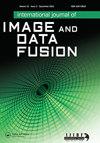无监督高光谱波段选择与深度自动编码器解混
IF 1.8
Q3 REMOTE SENSING
International Journal of Image and Data Fusion
Pub Date : 2021-08-30
DOI:10.1080/19479832.2021.1972047
引用次数: 10
摘要
高光谱成像(HSI)是许多民用和军事应用的有益信息来源,但高维数和强相关性限制了高光谱成像的分类性能。波段选择的目的是选择信息量最大的波段,以最小化计算成本和消除冗余信息。在本文中,我们提出了一种新的无监督波段选择方法,该方法受益于当前主流的深度学习框架。该方法包括两个连续的阶段:解混和聚类。在解混阶段,我们利用非线性深度自编码器提取准确的物质光谱。在聚类阶段,我们计算每个获得的端元的方差,以构造方差向量。然后,采用经典k均值对方差向量进行聚类。最后,每个聚类只选择一个光谱波段,得到最优波段子集。我们在三个高光谱数据集上进行了多次实验,以测试所提出方法的可行性和通用性。实验结果表明,所提出的方法在总体精度方面比几种最先进的方法平均高出4%。本文章由计算机程序翻译,如有差异,请以英文原文为准。
Unsupervised hyperspectral band selection with deep autoencoder unmixing
ABSTRACT Hyperspectral imaging (HSI) is a beneficial source of information for numerous civil and military applications, but high dimensionality and strong correlation limits HSI classification performance. Band selection aims at selecting the most informative bands to minimise the computational cost and eliminate redundant information. In this paper, we propose a new unsupervised band selection approach that benefits from the current dominant stream of deep learning frameworks. The proposed approach consists of two consecutive phases: unmixing and cluster. In the unmixing phase, we utilised a nonlinear deep autoencoder to extract accurate material spectra. In the cluster phase, we calculate the variance for each obtained endmember to construct a variances vector. Then, classical K-mean was adopted to cluster the variances vectors. Finally, the optimal band subset was obtained by choosing only one spectral band for each cluster. We carried out several experiments on three hyperspectral datasets to test the feasibility and generality of the proposed approach. Experimental results indicate that the proposed approach surpasses several state-of-the-art counterparts by an average of 4% in terms of overall accuracy.
求助全文
通过发布文献求助,成功后即可免费获取论文全文。
去求助
来源期刊

International Journal of Image and Data Fusion
REMOTE SENSING-
CiteScore
5.00
自引率
0.00%
发文量
10
期刊介绍:
International Journal of Image and Data Fusion provides a single source of information for all aspects of image and data fusion methodologies, developments, techniques and applications. Image and data fusion techniques are important for combining the many sources of satellite, airborne and ground based imaging systems, and integrating these with other related data sets for enhanced information extraction and decision making. Image and data fusion aims at the integration of multi-sensor, multi-temporal, multi-resolution and multi-platform image data, together with geospatial data, GIS, in-situ, and other statistical data sets for improved information extraction, as well as to increase the reliability of the information. This leads to more accurate information that provides for robust operational performance, i.e. increased confidence, reduced ambiguity and improved classification enabling evidence based management. The journal welcomes original research papers, review papers, shorter letters, technical articles, book reviews and conference reports in all areas of image and data fusion including, but not limited to, the following aspects and topics: • Automatic registration/geometric aspects of fusing images with different spatial, spectral, temporal resolutions; phase information; or acquired in different modes • Pixel, feature and decision level fusion algorithms and methodologies • Data Assimilation: fusing data with models • Multi-source classification and information extraction • Integration of satellite, airborne and terrestrial sensor systems • Fusing temporal data sets for change detection studies (e.g. for Land Cover/Land Use Change studies) • Image and data mining from multi-platform, multi-source, multi-scale, multi-temporal data sets (e.g. geometric information, topological information, statistical information, etc.).
 求助内容:
求助内容: 应助结果提醒方式:
应助结果提醒方式:


